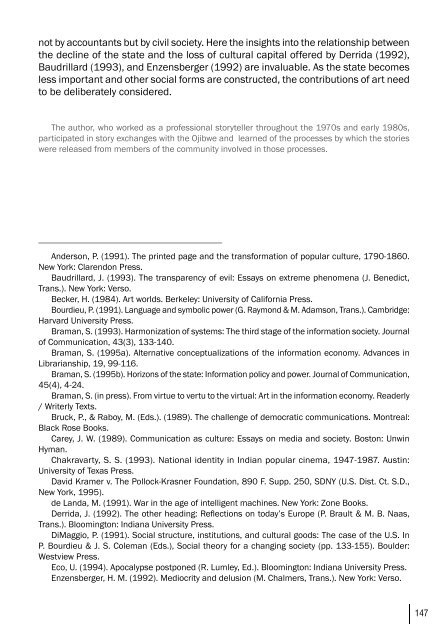art-e-conomy _ reader - marko stamenkovic
art-e-conomy _ reader - marko stamenkovic
art-e-conomy _ reader - marko stamenkovic
You also want an ePaper? Increase the reach of your titles
YUMPU automatically turns print PDFs into web optimized ePapers that Google loves.
not by accountants but by civil society. Here the insights into the relationship between<br />
the decline of the state and the loss of cultural capital offered by Derrida (1992),<br />
Baudrillard (1993), and Enzensberger (1992) are invaluable. As the state becomes<br />
less important and other social forms are constructed, the contributions of <strong>art</strong> need<br />
to be deliberately considered.<br />
The author, who worked as a professional storyteller throughout the 1970s and early 1980s,<br />
p<strong>art</strong>icipated in story exchanges with the Ojibwe and learned of the processes by which the stories<br />
were released from members of the community involved in those processes.<br />
Anderson, P. (1991). The printed page and the transformation of popular culture, 1790-1860.<br />
New York: Clarendon Press.<br />
Baudrillard, J. (1993). The transparency of evil: Essays on extreme phenomena (J. Benedict,<br />
Trans.). New York: Verso.<br />
Becker, H. (1984). Art worlds. Berkeley: University of California Press.<br />
Bourdieu, P. (1991). Language and symbolic power (G. Raymond & M. Adamson, Trans.). Cambridge:<br />
Harvard University Press.<br />
Braman, S. (1993). Harmonization of systems: The third stage of the information society. Journal<br />
of Communication, 43(3), 133-140.<br />
Braman, S. (1995a). Alternative conceptualizations of the information e<strong>conomy</strong>. Advances in<br />
Librarianship, 19, 99-116.<br />
Braman, S. (1995b). Horizons of the state: Information policy and power. Journal of Communication,<br />
45(4), 4-24.<br />
Braman, S. (in press). From virtue to vertu to the virtual: Art in the information e<strong>conomy</strong>. Readerly<br />
/ Writerly Texts.<br />
Bruck, P., & Raboy, M. (Eds.). (1989). The challenge of democratic communications. Montreal:<br />
Black Rose Books.<br />
Carey, J. W. (1989). Communication as culture: Essays on media and society. Boston: Unwin<br />
Hyman.<br />
Chakrav<strong>art</strong>y, S. S. (1993). National identity in Indian popular cinema, 1947-1987. Austin:<br />
University of Texas Press.<br />
David Kramer v. The Pollock-Krasner Foundation, 890 F. Supp. 250, SDNY (U.S. Dist. Ct. S.D.,<br />
New York, 1995).<br />
de Landa, M. (1991). War in the age of intelligent machines. New York: Zone Books.<br />
Derrida, J. (1992). The other heading: Reflections on today’s Europe (P. Brault & M. B. Naas,<br />
Trans.). Bloomington: Indiana University Press.<br />
DiMaggio, P. (1991). Social structure, institutions, and cultural goods: The case of the U.S. In<br />
P. Bourdieu & J. S. Coleman (Eds.), Social theory for a changing society (pp. 133-155). Boulder:<br />
Westview Press.<br />
Eco, U. (1994). Apocalypse postponed (R. Lumley, Ed.). Bloomington: Indiana University Press.<br />
Enzensberger, H. M. (1992). Mediocrity and delusion (M. Chalmers, Trans.). New York: Verso.<br />
147


